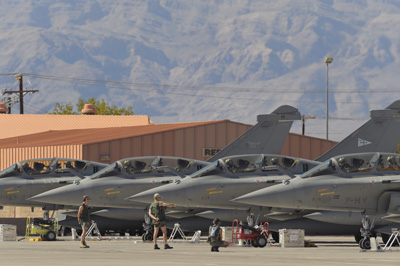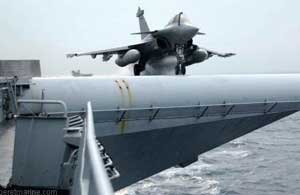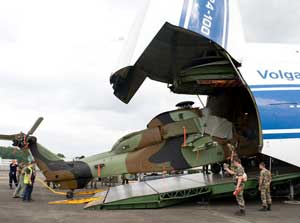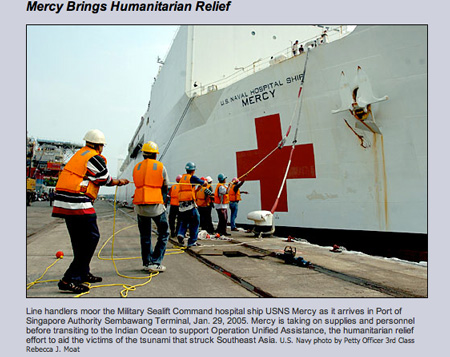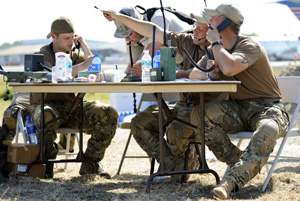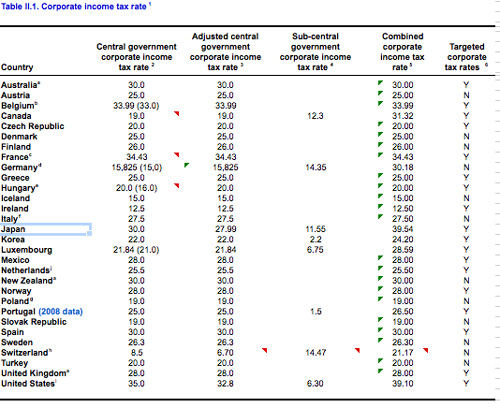Sldinfo is generating a series on game changers. What key technologies, organizational changes, or geo-political approaches will reshape the decade ahead? Associated with identification and assessment of forces for change, we will look at the world in 2020 which is only a decade away to better understand the shifting strategic and operational environment within which global military forces will operate.
D. K. Matai has written a lead essay for our game changers series, and provides a different way to look at the climate change debate. We will post this essay in three parts, with the first part published below. By re-framing that debate, he provides a macro perspective on the broad dynamics of change that will reshape the global macro-economic and geo-political structures.
D. K. Matai, Chairman mi2g, Phlanthropia, and ATCA, is an engineer turned entrepreneur and philanthropist with a keen interest in the well being of global society. DK founded mi2g in 1995, the global risk specialists, in London, UK, while developing simulations for his PhD at Imperial College. DK helped found ATCA – The Asymmetric Threats Contingency Alliance – in 2001, a philanthropic expert initiative to address complex global challenges through Socratic dialogue and joint executive action to build a wisdom based global economy. ATCA addresses opportunities and threats arising from climate chaos, radical poverty, organised crime, extremism, informatics, nanotechnology, robotics, genetics, artificial intelligence and financial systems. ATCA has 5,000+ distinguished members from over 100 countries: including several from the House of Lords, House of Commons, EU Parliament, US Congress & Senate, G10’s Senior Government officials and over 1,500 CEOs from financial institutions, scientific corporates, NGOs and 750+ Profs from academic centres of excellence.
***
Start Of The Great Freeze?

As the deep freeze continues across Europe, Asia and North America, conventional wisdom insists that this is merely a ‘blip’ of no long-term significance. More than half the surface of some of the most powerful countries in the Northern Hemisphere has been covered by snow this winter. That hasn’t happened for several decades.
Note the extreme temperatures in January 2010: Hamburg, Germany -22°C, coldest since 1963; Beijing, China -16°C, coldest since 1970; Nebraska, USA -15°C, coldest since 1973. An ATCA (Asymetric Threat Contingency Alliance) observer in Europe stated: “I live rurally and my elderly neighbor says that, before February last year, they hadn’t seen snow in our hamlet for 30 years. We’ve already been snowed in for nearly two weeks and we still can’t get out. That tells me everything I need to know!”
Towards a Mini-Ice Age?
Over the past decade there have been many warnings about Global Warming with precise extrapolations of temperature increase and projections of sea level rise. But the reality is that these physical climate processes are non-linear systems subject to wild fluctuations, with “flips” between alternative equilibrium states.
Is the bitter winter afflicting much of the Northern Hemisphere the start of a global trend towards much cooler weather that is likely to last in the longer term?
Some of the world’s most eminent climate scientists are suggesting that this might be the case. Their predictions are based on an analysis of natural cycles in water temperatures in the Pacific and Atlantic oceans. This demonstrates that much of the warming we witnessed in the last few decades was caused by oceanic cycles when they were in a ‘warm mode’ as opposed to the present ‘cold mode’.
This undermines the standard climate computer models, which assert that the warming of the Earth in the 20th and 21st centuries has been driven solely by anthropogenic, i.e., man-made greenhouse gas emissions and will continue to do so as long as carbon dioxide levels continue to rise.
Asserting that Climate Chaos partially induced by Global Warming could lead to a Mini Ice Age may seem cryptic, but non-linear dynamical systems do not operate in a straightforward fashion. Changes in the current temperature equilibrium could result in a flip to a new state after chaotically plotting through a wide range of possibilities. A warmer earth produces more precipitation, and so there may be greater snow-cover in winter, which increases the reflection of solar radiation. A new cycle of cooler temperatures triggered by greater reflection might then reduce rain precipitation, but significantly increase the proportion of snowfall. So there is the possibility of a positive feedback loop, leading to a runaway increase in snow-cover. Such a scenario is suggestive of a Mini Ice Age.
Among the most prominent of the scientists who share unorthodox views is Professor Mojib Latif, a leading member of the UN’s Intergovernmental Panel on Climate Change (IPCC). Prof Latif, who leads a research team at the world renowned Leibniz Institute at Germany’s Kiel University, has pioneered new methods for measuring ocean temperatures 3,000ft beneath the surface, where the cooling and warming cycles start. He and his colleagues predicted the new cooling trend in a paper published in 2008 and warned of it again at an IPCC conference in Geneva in September 2009.
Professor Mojib Latif states:
“A significant share of the warming we saw from 1980 to 2000 and at earlier periods in the 20th Century was due to these cycles – perhaps as much as 50 per cent. They have now gone into reverse, so winters like this one will become much more likely. Summers will also probably be cooler, and all this may well last two decades or longer. The extreme retreats that we have seen in glaciers and sea ice will come to a halt. For the time being, Global Warming has paused, and there may well be some cooling. Man-made warming is balanced by the natural cycles, and I do not trust the computer models, which state that if CO2 reaches a particular level, then temperatures and sea levels will rise by a given amount. These models cannot be trusted to predict the weather for a week, yet they are running them to give readings for 100 years.”
Arctic Oscillation and Multi-Decadal Oscillations (MDOs)
At one level it is true that the current freeze is the product of the ‘Arctic Oscillation’: a weather pattern that sees the development of huge ‘blocking’ areas of high pressure in northern latitudes, driving polar winds far to the south. Meteorologists say that this effect is at its strongest for at least 60 years.
However, according to various climate scientists, this in turn relates too much longer-term temperature shifts. Those are known as the Pacific and Atlantic ‘Multi-Decadal Oscillations’ (MDOs).
Professor Anastasios Tsonis, chief of the University of Wisconsin Atmospheric Sciences Group, has recently shown that these MDOs move together in a synchronized way across the globe, abruptly flipping the world’s climate from a ‘warm mode’ to a ‘cold mode’ and back again in 20 to 30-year cycles.
Professor Tsonis states:
“They [the MDOs] amount to massive rearrangements in the dominant patterns of the weather and their shifts explain all the major changes in world temperatures during the 20th and 21st Centuries. We have such a change now and can therefore expect 20 or 30 years of cooler temperatures. Many of the consequences of the recent warm mode were also observed 90 years ago.”
If some of the late 20th Century warming was caused not by carbon dioxide but by MDOs, then by how much? Professor Latif suggested it could be anything between 10 and 50 per cent.
Other critics of the global warming orthodoxy say the role played by MDOs is even greater. William Gray, emeritus Professor of Atmospheric Sciences at Colorado State University, said that while he believed there had been some background rise caused by greenhouse gases, the computer models used by advocates of man-made warming had hugely exaggerated their effect.
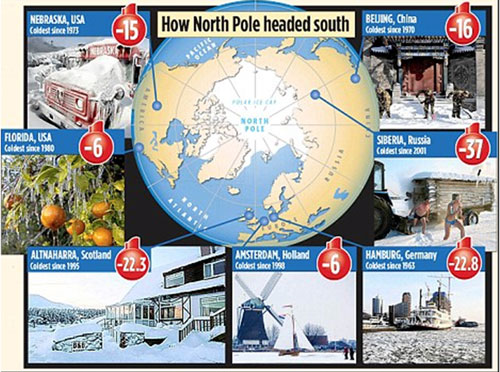
The “Hidden Rules of Non-Linear Chaos”
Working assumptions of policy makers and business leaders have been that their actions over the last year have opened the way for the global economic recovery to take hold.
However, Mother Nature may yet negate all these best efforts, via a period of a prolonged cold spell — The Great Freeze — that restricts transportation and production not just this winter but in winters to come. This could potentially derail common efforts to address The Great Unwind (2007-?) and The Great Reset (2008-?).
Some eminent climate scientists believe that in the coming few decades there may be no discernible Global Warming and what we might see is the onset of a Mini Ice Age due to Multi-Decadal Oscillations exaggerated by Global Warming. Their argument is strengthened by lessons from 20th century history.
Unpredictable possibilities and wild scenarios are not limited to climate. Our world rests upon finely-tuned and interlocking social systems and the synergies they create. The boundary conditions imposed by Malthus et al have been banished through innovation, productivity growth, and specialization of skills.
But like a space shuttle in flight, there are many delicate moving parts, which need to operate in perfect synchronization so that the modern technological civilization can continue to cruise at high altitude. The slightest defect or anomaly may ground it or send it shattering apart.
We could very soon witness severe disruption if the social capital of trust and security, which modern humans depend upon, evaporates due to environmental instability or climate chaos. Just as climatic systems instability may be driven by feedback loops, so trust and social capital could quickly be damaged by the emergence of unforeseen feedback loops on the climate front.
Let us note that the art of extrapolation and prediction is governed by the hidden rules of non-linear chaos rather than the clear axioms of linear geometry. Some of the clean and predictable certainties of the modern world are built upon the elegant logic of Newtonian mechanics, but the dynamical chaos which looms within and without our civilization, has the capacity to ground the elegant technological flight we are embarked upon.
We may live to regret our significant ignorance of the climatic unknown unknowns and lack of willingness to turn them into known unknowns despite the knowledge available and mounting evidence and incentives to do so.
———–
***Posted February 8th, 2010











